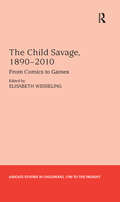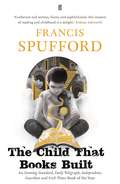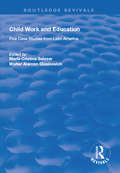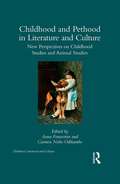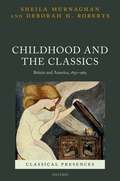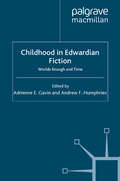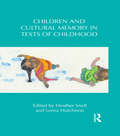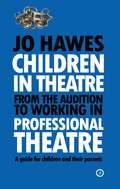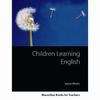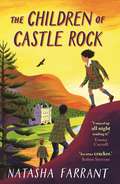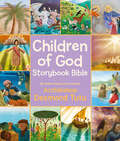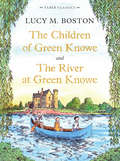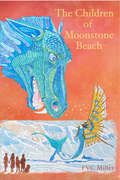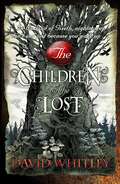- Table View
- List View
The Child Savage, 1890–2010: From Comics to Games (Studies in Childhood, 1700 to the Present)
by Elisabeth WesselingTaking up the understudied relationship between the cultural history of childhood and media studies, this volume traces twentieth-century migrations of the child-savage analogy from colonial into postcolonial discourse across a wide range of old and new media. Older and newer media such as films, textbooks, children's literature, periodicals, comic strips, children's radio, and toys are deeply implicated in each other through ongoing 'remediation', meaning that they continually mimic, absorb and transform each other's representational formats, stylistic features, and content. Media theory thus confronts the cultural history of childhood with the challenge of re-thinking change in childhood imaginaries as transformation-through-repetition patterns, rather than as rise-shine-decline sequences. This volume takes up this challenge, demonstrating that one historical epoch may well accommodate diverging childhood repertoires, which are recycled again and again as they are played out across a whole gamut of different media formats in the course of time.
The Child Savage, 1890–2010: From Comics to Games (Studies in Childhood, 1700 to the Present)
by Elisabeth WesselingTaking up the understudied relationship between the cultural history of childhood and media studies, this volume traces twentieth-century migrations of the child-savage analogy from colonial into postcolonial discourse across a wide range of old and new media. Older and newer media such as films, textbooks, children's literature, periodicals, comic strips, children's radio, and toys are deeply implicated in each other through ongoing 'remediation', meaning that they continually mimic, absorb and transform each other's representational formats, stylistic features, and content. Media theory thus confronts the cultural history of childhood with the challenge of re-thinking change in childhood imaginaries as transformation-through-repetition patterns, rather than as rise-shine-decline sequences. This volume takes up this challenge, demonstrating that one historical epoch may well accommodate diverging childhood repertoires, which are recycled again and again as they are played out across a whole gamut of different media formats in the course of time.
The Child that Books Built: A Memoir Of Childhood And Reading
by Francis SpuffordChildren's books - from Narnia to The Hobbit - are celebrated in this enlightened examination of the joys of childhood reading.Fairy tales and Where the Wild Things Are, The Lord of the Rings and the Narnia books, Little House on the Prairie and The Earthsea Trilogy. What would you find if you went back and re-read your favourite books from childhood? Francis Spufford discovers both delight and sadness, in this widely celebrated memoir of a boy who retreats into books, faced with a tragedy in his family.'A beautifully composed and wholly original memoir, sounding the classics of children's literature.' David Sexton, Evening Standard'Exuberant and serious, funny and sophisticated, this memoir of reading and childhood is a delight.' Andrea Ashworth
Child Work and Education: Five Case Studies from Latin America (Routledge Revivals)
by Walter Alarcon Glasinovich María Cristina SalazarPublished in 1998. In recent years research, as well as the results of practical programmes, has led to a clearer understanding of the relationship between child work and education. It is increasingly evident that child work is not entirely the result of economic need or exploitation. Frequently is the failure of educational system to offer adequate, stimulating and affordable schooling that encourages children to drop out in favour of work that appears to offer advantages more relevant to their everyday lives. Parents too may undervalue the role and purpose of a school that provides inadequate preparation for the future and often see a job, including home-based work, as a positive alternative to crime, delinquency or begging. Consequently, while a distinction needs to be made between ‘formative child work’ and ‘harmful child work’, in certain situations and cultures the phenomenon is not always seen as negative. Yet, although gratifying in the short term and sometimes even providing the means for a younger child to attend school as well as a way of learning discipline and responsibility, often these jobs provide no useful experience and do not lead to an improvement in the personal development of life chances of a child. The situation is therefore complex and requires a more realistic evolution of the relationship between archaic pedagogy, dropout rates and child work. These five case studies from Latin America all reveal the effects of inappropriate school curricular. Desertion of the educational system for the labour market leads to inadequate training and perpetuates the poverty trap. As part of the commitment to combating work which is detrimental to the child, major educational reform is needed. Improvements in coverage, quality and affordability should lead to greater acceptance pf schooling at all levels of society and provide a greater incentive for parents and children alike to participate more fully in the system. Moreover, in cases of severe economic hardship and forced or harmful labour, practical assistance with subsides and scholarships should be considered to remove children from such work.
Child Work and Education: Five Case Studies from Latin America (Routledge Revivals)
by MARÍA CRISTINA SALAZAR AND WALTER ALARCÓN GLASINOVICHPublished in 1998. In recent years research, as well as the results of practical programmes, has led to a clearer understanding of the relationship between child work and education. It is increasingly evident that child work is not entirely the result of economic need or exploitation. Frequently is the failure of educational system to offer adequate, stimulating and affordable schooling that encourages children to drop out in favour of work that appears to offer advantages more relevant to their everyday lives. Parents too may undervalue the role and purpose of a school that provides inadequate preparation for the future and often see a job, including home-based work, as a positive alternative to crime, delinquency or begging. Consequently, while a distinction needs to be made between ‘formative child work’ and ‘harmful child work’, in certain situations and cultures the phenomenon is not always seen as negative. Yet, although gratifying in the short term and sometimes even providing the means for a younger child to attend school as well as a way of learning discipline and responsibility, often these jobs provide no useful experience and do not lead to an improvement in the personal development of life chances of a child. The situation is therefore complex and requires a more realistic evolution of the relationship between archaic pedagogy, dropout rates and child work. These five case studies from Latin America all reveal the effects of inappropriate school curricular. Desertion of the educational system for the labour market leads to inadequate training and perpetuates the poverty trap. As part of the commitment to combating work which is detrimental to the child, major educational reform is needed. Improvements in coverage, quality and affordability should lead to greater acceptance pf schooling at all levels of society and provide a greater incentive for parents and children alike to participate more fully in the system. Moreover, in cases of severe economic hardship and forced or harmful labour, practical assistance with subsides and scholarships should be considered to remove children from such work.
Childhood and Pethood in Literature and Culture: New Perspectives in Childhood Studies and Animal Studies (Children's Literature and Culture)
by Anna Feuerstein Carmen Nolte-OdhiamboBringing together new perspectives in childhood studies and animal studies, this book is the first collection to critically address the manifold alignments and frequent co-constitutions of children and pets in our families, our cultures, and our societies. The cultural politics of power shaping relationships between children, pets, and adults inform the wide range of essays included in this collection, as they explore issues such as protection, discipline, mastery, wildness, play, and domestication. The volume use the frequent social and cultural intersections between children and pets as an opportunity to analyze institutions that create pet and child subjectivity, from education and training to putting children and pets on display for entertainment purposes. Essays analyze legal discourses, visual culture, literature for children and adults, migration narratives, magazines for children, music, and language socialization to discuss how notions of nationalism, race, gender, heteronormativity, and speciesism shape cultural constructions of children and pets. Examining childhood and pethood in America, Europe, Asia, and the Pacific, this collection shows how discourses linking children and pets are pervasive and work across cultures. By presenting innovative approaches to the child and the pet, the book brings to light alternative paths toward understanding these figures, leading to new openings and questions about kinship, agency, and the power of care that so often shapes our relationships with children and animals. This will be an important volume for scholars of animal studies, childhood studies, children’s literature, cultural studies, political theory, education, art history, and sociology.
Childhood and Pethood in Literature and Culture: New Perspectives in Childhood Studies and Animal Studies (Children's Literature and Culture)
by Anna Feuerstein Carmen Nolte-OdhiamboBringing together new perspectives in childhood studies and animal studies, this book is the first collection to critically address the manifold alignments and frequent co-constitutions of children and pets in our families, our cultures, and our societies. The cultural politics of power shaping relationships between children, pets, and adults inform the wide range of essays included in this collection, as they explore issues such as protection, discipline, mastery, wildness, play, and domestication. The volume use the frequent social and cultural intersections between children and pets as an opportunity to analyze institutions that create pet and child subjectivity, from education and training to putting children and pets on display for entertainment purposes. Essays analyze legal discourses, visual culture, literature for children and adults, migration narratives, magazines for children, music, and language socialization to discuss how notions of nationalism, race, gender, heteronormativity, and speciesism shape cultural constructions of children and pets. Examining childhood and pethood in America, Europe, Asia, and the Pacific, this collection shows how discourses linking children and pets are pervasive and work across cultures. By presenting innovative approaches to the child and the pet, the book brings to light alternative paths toward understanding these figures, leading to new openings and questions about kinship, agency, and the power of care that so often shapes our relationships with children and animals. This will be an important volume for scholars of animal studies, childhood studies, children’s literature, cultural studies, political theory, education, art history, and sociology.
Childhood and the Classics: Britain and America, 1850-1965 (Classical Presences)
by Sheila Murnaghan Deborah H. RobertsThe dissemination of classical material to children has long been a major form of popularization with far-reaching effects, although until very recently it has received almost no attention within the growing field of classical reception studies. This volume explores the ways in which children encountered the world of ancient Greece and Rome in Britain and the United States over a century-long period beginning in the 1850s, as well as adults' literary responses to their own childhood encounters with antiquity. Rather than discussing the role of classics in education, it focuses on books read for enjoyment, and on two genres of children's literature in particular: the myth collection and the historical novel. The tradition of myths retold as children's stories is traced in the work of writers and illustrators from Nathaniel Hawthorne and Charles Kingsley to Roger Lancelyn Green and Ingri and Edgar Parin D'Aulaire, while the discussion of historical fiction focuses particularly on the roles of nationality and gender in the construction of an ancient world for modern children. The book concludes with an investigation of the connections between childhood and antiquity made by writers for adults, including James Joyce, Virginia Woolf, and H.D. Recognition of the fundamental role in children's literature of adults' ideas about what children want or need is balanced throughout by attention to the ways in which child readers have made such works their own. The formative experiences of antiquity discussed throughout help to explain why despite growing uncertainty about the appeal of antiquity to modern children, the classical past remains perennially interesting and inspiring.
Childhood and the Classics: Britain and America, 1850-1965 (Classical Presences)
by Sheila Murnaghan Deborah H. RobertsThe dissemination of classical material to children has long been a major form of popularization with far-reaching effects, although until very recently it has received almost no attention within the growing field of classical reception studies. This volume explores the ways in which children encountered the world of ancient Greece and Rome in Britain and the United States over a century-long period beginning in the 1850s, as well as adults' literary responses to their own childhood encounters with antiquity. Rather than discussing the role of classics in education, it focuses on books read for enjoyment, and on two genres of children's literature in particular: the myth collection and the historical novel. The tradition of myths retold as children's stories is traced in the work of writers and illustrators from Nathaniel Hawthorne and Charles Kingsley to Roger Lancelyn Green and Ingri and Edgar Parin D'Aulaire, while the discussion of historical fiction focuses particularly on the roles of nationality and gender in the construction of an ancient world for modern children. The book concludes with an investigation of the connections between childhood and antiquity made by writers for adults, including James Joyce, Virginia Woolf, and H.D. Recognition of the fundamental role in children's literature of adults' ideas about what children want or need is balanced throughout by attention to the ways in which child readers have made such works their own. The formative experiences of antiquity discussed throughout help to explain why despite growing uncertainty about the appeal of antiquity to modern children, the classical past remains perennially interesting and inspiring.
Childhood in Edwardian Fiction: Worlds Enough and Time
by A. Gavin A. HumphriesThe first book-length look at childhood in Edwardian fiction, this book challenges assumptions that the Edwardian period was simply a continuation of the Victorian or the start of the Modern. Exploring both classics and popular fiction, the authors provide a a compelling picture of the Edwardian fictional cult of childhood.
Children Also Grieve: Talking about Death and Healing (PDF)
by Linda GoldmanChildren Also Grieve is an imaginative resource, fully illustrated with color photographs, that offers support and reassurance to children coming to terms with the loss of a close friend or relative and to adults who are supporting them through their bereavement. The first part of the book is designed to be read and worked through by children. The story tells of the experiences of Henry, the dog of a family whose grandfather has died. During Henry's progress through the different stages of bereavement, he learns strategies for coping with his grief. At various stages of the story, Goldman provides readers with the opportunity to share their own reactions to loss through words and pictures, using specific prompt questions that encourage the exploration of different facets of grief. The second part includes a list of useful vocabulary to help children express their feelings about bereavement, a bibliography of other useful resources for both children and adults, and a section that will help adults to understand and aid children throughout the grief process. This last section also explains the approach taken in the story, details typical responses to bereavement, and discusses useful ways in which adults can discuss and share grief with children. This book is an invaluable tool for bereaved children and those who care for them.
Children and Biography: Reading and Writing Life Stories (New Directions in Life Narrative)
by Kate DouglasThe first study of life narratives produced for, about, and written by children, this book examines the recent popularity of children's biographies and how they engage with the biggest issues of our time: environmental change, health crises, education, and children's personal and political development. Beginning with a literary-historical overview, Children and Biography proceeds to examine 21st-century examples and trends such as illustrated texts including Women in Science, the Fantastically Great Women Who… books, Rebel Dogs, Goodnight Stories for Rebel Girls, Kids Who Did, My Beautiful Birds and The Journey. The book also considers archives of children's writings and drawings, in particular the testimonies of child asylum seekers, children's biographical art, and 'Lockdown diaries' produced during the Covid-19 pandemic. By analyzing these works alongside empirical studies into how such material is received by child readers, and how texts generated by children are perceived both by them and their parents, this book provides new knowledge on how biographies for children are produced and read. Comprehensive and original, Children and Biography, presents an ethical methodological framework for scholarly practice when reading, witnessing and interpreting children's life narratives. The book offers a mandate for future researchers: to place children's voices and writing at the centre of inquiries in ways that facilitate genuine agency for child authors.
Children and Biography: Reading and Writing Life Stories (New Directions in Life Narrative)
by Kate DouglasThe first study of life narratives produced for, about, and written by children, this book examines the recent popularity of children's biographies and how they engage with the biggest issues of our time: environmental change, health crises, education, and children's personal and political development. Beginning with a literary-historical overview, Children and Biography proceeds to examine 21st-century examples and trends such as illustrated texts including Women in Science, the Fantastically Great Women Who… books, Rebel Dogs, Goodnight Stories for Rebel Girls, Kids Who Did, My Beautiful Birds and The Journey. The book also considers archives of children's writings and drawings, in particular the testimonies of child asylum seekers, children's biographical art, and 'Lockdown diaries' produced during the Covid-19 pandemic. By analyzing these works alongside empirical studies into how such material is received by child readers, and how texts generated by children are perceived both by them and their parents, this book provides new knowledge on how biographies for children are produced and read. Comprehensive and original, Children and Biography, presents an ethical methodological framework for scholarly practice when reading, witnessing and interpreting children's life narratives. The book offers a mandate for future researchers: to place children's voices and writing at the centre of inquiries in ways that facilitate genuine agency for child authors.
Children and Cultural Memory in Texts of Childhood (Children's Literature and Culture)
by Heather Snell Lorna HutchisonThe essays in this collection address the relationship between children and cultural memory in texts both for and about young people. The collection overall is concerned with how cultural memory is shaped, contested, forgotten, recovered, and (re)circulated, sometimes in opposition to dominant national narratives, and often for the benefit of young readers who are assumed not to possess any prior cultural memory. From the innovative development of school libraries in the 1920s to the role of utopianism in fixing cultural memory for teen readers, it provides a critical look into children and ideologies of childhood as they are represented in a broad spectrum of texts, including film, poetry, literature, and architecture from Canada, the United States, Japan, Germany, Britain, India, and Spain. These cultural forms collaborate to shape ideas and values, in turn contributing to dominant discourses about national and global citizenship. The essays included in the collection imply that childhood is an oft-imagined idealist construction based in large part on participation, identity, and perception; childhood is invisible and tangible, exciting and intriguing, and at times elusive even as cultural and literary artifacts recreate it. Children and Cultural Memory in Texts of Childhood is a valuable resource for scholars of children’s literature and culture, readers interested in childhood and ideology, and those working in the fields of diaspora and postcolonial studies.
Children and Cultural Memory in Texts of Childhood: Children And Cultural Memory In Texts Of Childhood (Children's Literature and Culture)
by Heather Snell Lorna HutchisonThe essays in this collection address the relationship between children and cultural memory in texts both for and about young people. The collection overall is concerned with how cultural memory is shaped, contested, forgotten, recovered, and (re)circulated, sometimes in opposition to dominant national narratives, and often for the benefit of young readers who are assumed not to possess any prior cultural memory. From the innovative development of school libraries in the 1920s to the role of utopianism in fixing cultural memory for teen readers, it provides a critical look into children and ideologies of childhood as they are represented in a broad spectrum of texts, including film, poetry, literature, and architecture from Canada, the United States, Japan, Germany, Britain, India, and Spain. These cultural forms collaborate to shape ideas and values, in turn contributing to dominant discourses about national and global citizenship. The essays included in the collection imply that childhood is an oft-imagined idealist construction based in large part on participation, identity, and perception; childhood is invisible and tangible, exciting and intriguing, and at times elusive even as cultural and literary artifacts recreate it. Children and Cultural Memory in Texts of Childhood is a valuable resource for scholars of children’s literature and culture, readers interested in childhood and ideology, and those working in the fields of diaspora and postcolonial studies.
Children in Culture, Revisited: Further Approaches to Childhood
by Karín Lesnik-ObersteinChildren in Culture, Revisited follows on from the first volume, Children in Culture , and is composed of a range of chapters, newly written for this collection, which offer further fully inter- and multidisciplinary considerations of childhood as a culturally and historically constructed identity rather than a constant psycho-biological entity.
Children in Theatre: A guide for children and their parents
by Jo HawesPerforming children have a very special existence which sometimes sets them apart from their peers. Parents are often excluded from this world but are expected to support them all the way. There is very little authoritative advice on how to cope and what to expect. This book will help children and their parents navigate their way through all of this: to advise, guide, inform and demystify the wonderful world of live theatre. Packed full of practical advice and information on all aspects of the life of a child actor, it is written by the leading children’s casting director and administrator in the UK, who has worked on many large-scale West End shows including Oliver!, Shrek, The Sound of Music, Mary Poppins and Matilda.
Children Learning English (PDF)
by J. MoonChildren Learning English reveals the special features of teaching foreign languages to young learners. It is an inspiring read and a useful practical guide in a single volume.
The Children of Castle Rock
by Natasha FarrantSt Trinians and Lauren St John collide in this hilarious and thrilling bestselling adventure from Natasha Farrant!When Alice Mistlethwaite is shipped off to boarding school in Scotland it's nothing like she imagines. Run by the mysterious Major, there are no punishments and the students are more likely to be taught about body painting or extreme survival than maths or English!Then Alice's dad goes missing and she must run away to find him. Can she persuade her new friends to help?So begins an epic quest across wild Scottish highlands and islands, where friendships will be made and broken, lies will be untangled and the children will face danger and excitement at every turn . . .Both hilarious and heartfelt, this is the classic adventure story brought bang up to date, and told in Natasha's inimitable voice.'Thrilling adventure.' The Times'This wise and touching novel has originality and a fresh voice.' Sunday Times'A gripping adventure . . . I stayed up all night reading it!' Emma Carroll, author of Letters from the Lighthouse
Children Of The Dust (Red Fox Young Adult Bks.)
by Louise LawrenceA powerful post-nuclear holocaust novel described by the author as, 'my cry against the monstrous weapons men have made'.Everyone thought, when the alarm bell rang, that it was just another fire practice. But the first bombs had fallen on Hamburg and Leningrad, the headmaster said, and a full-scale nuclear attack was imminent . . .It's a real-life nightmare. Sarah and her family have to stay cooped up in the tightly-sealed kitchen for days on end, dreading the inevitable radioactive fall-out and the subsequent slow, torturous death, which seems almost preferable to surviving in a grey, dead world, choked by dust.But then, from out of the dust and the ruins and the desolation, comes new life, a new future, and a whole brave new world...
Children of God Storybook Bible
by Archbishop Desmond TutuA beautiful book of Bible stories, retold by the world’s best-loved cleric.
The Children of Green Knowe Collection
by Lucy M. BostonThe Children of Green Knowe Collection brings the Lucy Boston classics The Children of Green Knowe and River at Green Knowe together in one beautifully packaged edition.These enchanting, haunting stories from Carnegie winner Lucy M. Boston have become modern classics, beautifully evoking all the magic and wonder of childhood. Now The Children of Green Knowe and River at Green Knowe are available in one edition.Children of Green KnoweTolly's great grandmother isn't a witch, but both she and her old house, Green Knowe, are full of a very special kind of magic. There are other children in the house - children who were happy there centuries before. Running around Green Knowe's moat, gardens and mysterious rooms, Tolly slowly discovers them, their toys and animals, and their wonderful stories . . .River at Green Knowe'What a lot of islands the river makes,' said Ida. 'We must go exploring and sail around them all.'And so begins a wonderful, magical summer. Ida, Oscar and Ping are staying with Ida's great-aunt at the ancient, river-encircled house of Green Knowe. They set out to chart the river in the canoe, and soon discover that it has some surprising and mysterious secrets.'An award-winning classic story of a friendship.' LoveReading4Kids'Magic, mystery and fun will bring listeners along for an entertaining ride.' Publishers Weekly
The Children of Moonstone Beach
by F V MillerDo you have a moonstone tucked away at the back of a drawer? If you do, then dig it out, hold it close and read this heartfelt adventure, because you are invited to dive wholeheartedly into the magical world of Moontide, where almost anything can happen with a moonstone in your hand. Join four unlikely friends as they are thrown together on a beach far away from their homes in London amidst the chaos of the Covid pandemic as it hits the UK. Troubled, lost, sad and with hearts searching for more, they unknowingly kickstart a chain of events which sees them swept up into a new and spellbinding world; one that has been waiting patiently for their arrival for a very long time. With royal dragons, howling wolves, evil magic-maker pirates, a sea nymph, a bog monster, flying cats and a war to wage, the children must find out who they really are before they can embrace the magic they hold within.
Children Of The Quicksands (ebook)
by Efua TraoreIn a remote Nigerian village, twelve-year-old Simi is desperate to uncover a family secret. But it’s when she’s caught in the red quicksand of a forbidden lake that her adventure truly begins. Can she bring her family back together and restore peace to the village?
The Children of the Lost (The\agora Trilogy Ser. #2)
by David WhitleyMARK AND LILY HAVE BEEN BANISHED from Agora, the ancient city-state where everything is for sale - memories, emotions - even children.Lost and alone they discover Giseth, a seemingly perfect land where everyone is equal, possessions are unknown, and Lily believes they will find the secret of their entwined destiny. But paradise comes at a price. Why are their new friends so scared? What hides deep in the forest? And who is the mysterious woman who appears in their dreams, urging them to find the Children of the Lost?
